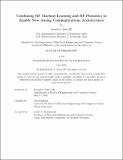Combining RF Machine Learning and RF Photonics to Enable New Analog Communications Architectures
Author(s)
Davis III, Ronald A.
DownloadThesis PDF (9.255Mb)
Advisor
Englund, Dirk
Terms of use
Metadata
Show full item recordAbstract
High-performance communications links and the increasing reliance on artificial intelligence are creating an exponentially increasing demand for higher data rates and computing performance. However, Moore’s Law of exponentially growing computing capabilities has slowed, meaning that the traditional computing architecture has reached a bottleneck in processing performance, largely due to data movement. Considerable efforts have been made to create custom hardware to accelerate deep neural network training and inference. Among these efforts are optical neural networks (ONNs), which have been a promising approach that excel at linear operations but struggle with nonlinear implementations and scalability. Here, an LTI Simulation Toolkit has been created to facilitate rapid iterative photonic circuit designing to quickly evaluate ONN architectures. The LTI Toolkit interprets the electromagnetic (EM) waves as LTI inputs into a transfer function that obeys the analytical solutions of the photonic components. Thus, this LTI toolkit was a stepping stone to designing the primary result of this work—the ONN architecture called the multiplicative analog frequency transform optical neural network (MAFT-ONN), implementing single-shot matrix products and single-shot nonlinear activations using a single device for all neurons in a layer. We demonstrate its RF signal processing capabilities by experimentally implementing various signal processing operations like matched filters, Wiener filters, and linear signal estimation as well as a 3-layer DNN for modulation classification of raw RF signals, thus being the first recorded analog hardware accelerator to ever perform deep learning directly on raw RF signals. We also present a system-level analysis to quantitatively show that the MAFT architecture is hundreds of times faster than even the theoretical peak performance of modern digital architectures in communications systems.
Date issued
2024-05Department
Massachusetts Institute of Technology. Department of Electrical Engineering and Computer SciencePublisher
Massachusetts Institute of Technology